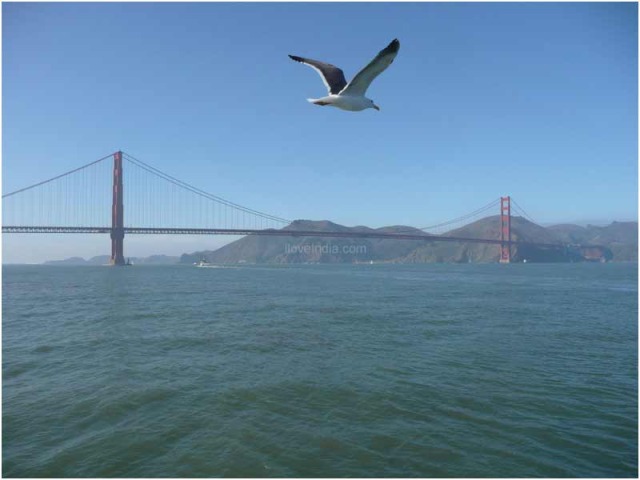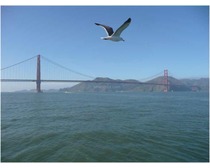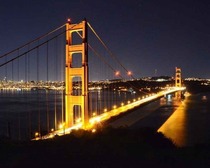The Golden Gate Bridge is an internationally acclaimed symbol of San Francisco and California. Read further to know some interesting fun facts about the Golden Gate Bridge.
Facts About Golden Gate Bridge
Colored in 'International Orange', the Golden Gate Bridge is amongst the most amazing architectural marvels of the world. The bridge, being part of both U.S. Route 101 and State Route 1, connects the city of San Francisco on the northern tip of the San Francisco Peninsula to Marin County. When it was completed in 1937, the Golden Gate Bridge had the longest suspension bridge span in the world and became the global symbol of San Francisco and California. Since its completion, its span length has been outdone by eight other bridges. However, it boasts of the second longest suspension bridge main span in the United States. In 2007, the Golden Gate Bridge ranked fifth on the List of America's Favorite Architecture by the American Institute of Architects. To know more such interesting and fun facts about the Golden Gate Bridge, read on.

Interesting and Fun Facts about Golden Gate Bridge
- The actual 'Golden Gate' is the strait that the bridge spans. Initially it was named "Chrysopylae" connoting "golden gate" by Captain John C. Fremont in 1846.
- The Golden Gate Bridge is colossal. Its total length is 1.7 miles (8,981 feet or 2,737 m), middle span is 4,200 feet (1,966 m) and width is 90 feet (27 m). It is built at a height (average) of 220 feet (67 m) above water.
- It weighed 894,500 tons (811,500,000 kg) when it was built. Today, it weighs 887,000 tons (804,700,000 kg); the weight got reduced due to new decking material.
- Its strong towers stand 746 feet (227 m) high above the water and 500 feet (152 m) above the roadway. Each leg of the tower is 33 x 54 feet (10 x 16 m) and each tower weighs 44,000 tons (40,200,000 kg). Moreover, there are about 600,000 rivets in each tower.
- Only 11 workers died during the construction work of the bridge which is a safety record for the time. Around 35 people were expected to die during the construction by the builders. At the time of the bridge's construction, a net was suspended under the floor which saved the lives of 19 men.
- The total steel used in the bridge was made in New Jersey, Maryland and Pennsylvania, and was shipped through the Panama Canal. Its total weight is 83,000 tons (75,293,000 kg).
- The bridge has two main cables which pass over the tops of the main towers and are held in concrete anchorages at each end. Each cable is made of 27,572 strands of wire, and there are 80,000 miles (129,000 km) of wire in the two main cables. It took more than six months to spin these cables. Each cable is 7,260 feet (2,332 m) long and its diameter is 36 3/8 inches (0.92 m).
- On the bridge roadway, about 128 lights, which are 250-watt high pressure sodium lamps, are installed. While the 24 tower sidewalk lights are 35-watt low pressure sodium lamps. An airway beacon tops each tower, and 24 lights of 400 watts each illuminate both the towers.
- Since its establishment, the bridge has been closed only for three times due to adverse weather conditions: on December 1, 1951, due to gusts of 69 mph (111 km/h); on December 23, 1982, due to gusts of 70 mph (113 km/h); and on December 3, 1983, due to gusts of 75 mph (121 km/h). The Bridge was also closed on its 50th birthday.
- On an average, about 40 million vehicles cross the bridge every year, including both north and southbound crossings.
- The construction work of the Golden Gate Bridge began on January 5, 1933.
- On May 27, 1937, the bridge was opened to pedestrians and to automobiles on the consecutive day.
- The bridge is painted in orange vermillion color, also known as international orange. Irving Morrow, the architect of the bridge, chose the color because it goes well with the bridge's setting.
- Initially, the bridge was fully painted and then touched up for the next 27 years. In 1965, the original paint was removed due to corrosion and was replaced with an inorganic zinc silicate primer and an acrylic emulsion top coat; the project took 30 years. These days, its paint is touched up regularly.
- The Golden Gate Bridge was the longest suspension bridge until the Verrazano Narrows Bridge in New York replaced the title in 1964.
- The bridge was built with a whopping construction cost of $35 million.
- The fog around the Golden Gate Bridge is called "advection fog." Such fog forms when humid air from the Pacific swoops over the chilly California current. The bridge has an influence in directing the fog as it pushes up and pours the fog around the bridge.


See also
More from iloveindia.com
- Home Remedies | Ayurveda | Vastu | Yoga | Feng Shui | Tattoos | Fitness | Garden | Nutrition | Parenting | Bikes | Cars | Baby Care | Indian Weddings | Festivals | Party ideas | Horoscope 2015 | Pets | Finance | Figures of Speech | Hotels in India : Delhi | Hyderabad | Chennai | Mumbai | Kolkata | Bangalore | Ahmedabad | Jaipur
- Contact Us Careers Disclaimer Privacy Policy Advertise With Us Lifestyle Sitemap Copyright iloveindia.com. All Rights Reserved.





